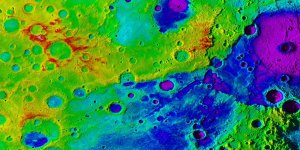| News / Space News |
Study Predicts Next Global Dust Storm on Mars
NASA | OCTOBER 18, 2016
Global dust storms on Mars could soon become more predictable -- which would be a boon for future astronauts there -- if the next one follows a pattern suggested by those in the past.

Two 2001 images from the Mars Orbiter Camera on NASA's Mars Global Surveyor orbiter show a dramatic change in the planet's appearance when haze raised by dust-storm activity in the south became globally distributed. The images were taken about a month apart. ![]()
Mars will reach the midpoint of its current dust storm season on October 29th of this year. Based on the historical pattern, it is very likely that a global dust storm will begin within a few weeks or months of this date.
Local dust storms occur frequently on Mars. These localized storms occasionally grow or coalesce to form regional systems, particularly during the southern spring and summer, when Mars is closest to the sun. On rare occasions, regional storms produce a dust haze that encircles the planet and obscures surface features beneath.
A few of these events may become truly global storms, such as one in 1971 that greeted the first spacecraft to orbit Mars, NASA's Mariner 9. Discerning a predictable pattern for which Martian years will have planet-encircling or global storms has been a challenge.
The most recent Martian global dust storm occurred in 2007, significantly diminishing solar power available to two NASA Mars rovers then active halfway around the planet from each other -- Spirit and Opportunity.
Dust storms also will present challenges for astronauts on the Red Planet. Although the force of the wind on Mars is not as strong as portrayed in an early scene in the movie "The Martian," dust lofted during storms could affect electronics and health, as well as the availability of solar energy.
The Red Planet has been observed shrouded by planet-encircling dust nine times since 1924, with the five most recent planetary storms detected in 1977, 1982, 1994, 2001 and 2007.
The actual number of such events is no doubt higher. In some of the years when no orbiter was observing Mars up close, Mars was poorly positioned for Earth-based telescopic detection of dust storms during the Martian season when global storms are most likely.
YOU MAY ALSO LIKE


